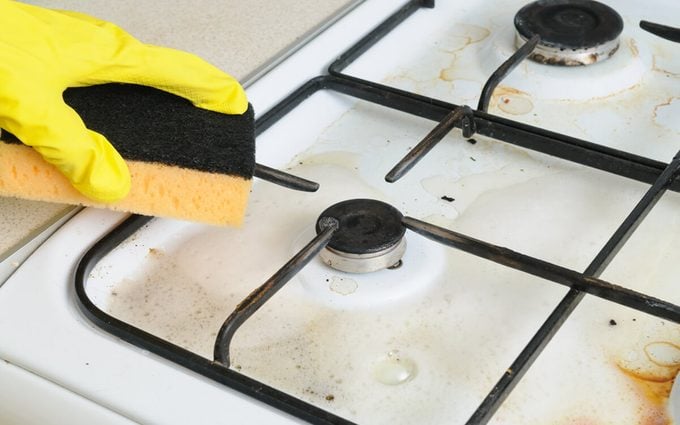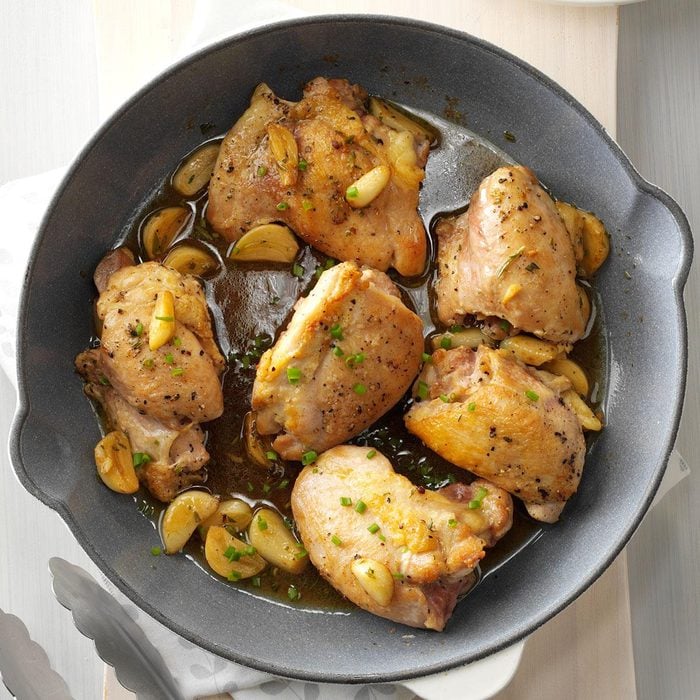All clean? Get cooking again with these stove-top wonders.
Chicken Burrito Skillet
We love Mexican night at our house, and I love to re-create dishes from our favorite restaurants. This burrito-inspired dish is ready for the table in almost no time! —Krista Marshall, Fort Wayne, Indiana
Get Recipe
Spicy Sausage and Rice SkilletThe spicy sausage in this quick skillet dish gives it a kick, and the sliced apples are a pleasant, tart surprise. —Jamie Jones, Madison, Georgia
Pair this recipe with one of our favorite
skillet side dishes.
Quick Moroccan Shrimp SkilletWhen my niece was attending West Point, she was sent to Morocco for five months. I threw her a going-away party complete with Moroccan decorations, costumes and cuisine, including this saucy shrimp dish. Whenever I make it now, I think of her and smile. —Barbara Lento, Houston, Pennsylvania
Sweet Potato and Egg SkilletI try to incorporate nutritious sweet potatoes in meals as often as possible, especially with breakfast. I came up with this recipe to feed my family a healthy, hearty breakfast—and it worked! —Jeanne Larson, Rancho Santa Margarita, California
Skip the meat with these
vegetarian skillet recipes.
Mexican Turkey SkilletThis family-friendly main dish with turkey, black beans and vegetables has a rich Mexican flavor that may seem indulgent, but it’s delightfully light. Created by our Test Kitchen, it cooks in one skillet, so it’s a snap to clean up for a weeknight supper.
Chicken Bulgur SkilletThis recipe was passed on to me by a friend. I've altered it slightly to suit our tastes. We like it with a fresh green salad. —Leann Hilmer, Sylvan Grove, Kansas
Beef Barley SkilletThis versatile dish goes together fast since it's made with quick-cooking barley. You can make it with ground turkey or chicken and any color bell pepper that you have on hand. —Irene Tetreault, South Hadley, Massachusetts
No gluten? No problem.
These skillet meals are gluten-free.
Chicken & Goat Cheese SkilletMy husband was completely bowled over by this on-a-whim goat cheese and chicken skillet meal. I can't wait to make it again very soon! —Ericka Barber, Eureka, California
Curried Chicken SkilletThis protein-packed skillet dish is loaded with bright flavor. A little curry and fresh ginger make the veggies, chicken and quinoa pop. —Ruth Hartunian-Alumbaugh, Willimantic, Connecticut
Check out our
easiest skillet meals ever. Each recipe has just 4 ingredients!
Italian Sausage Veggie SkilletWe love Italian sausage sandwiches, but because the bread isn't diet-friendly for me, I created this recipe to satisfy my craving. If you like some heat, use hot peppers in place of the sweet peppers. —Tina Howells, Salem, Ohio
Skillet-Roasted Lemon Chicken with PotatoesThis is a meal I have my students make in our nutrition unit. It has a delicious lemon-herb flavor and is simple to make. —Mindy Rottmund, Lancaster, Pennsylvania
Potato-Topped Ground Beef SkilletCompared to other ground beef skillet recipes, the depth of flavor in this recipe is amazing, and I never have leftovers when I take it to potlucks. I love recipes that I can cook and serve in the same skillet. If your butcher has chili grind beef, which is coarsely ground, go for that; it lends an extra meaty texture. —Fay Moreland, Wichita Falls, Texas
Chicken Orzo SkilletAs a busy homemaker with a home-based business, I try to make quick dinners that are healthy for my husband and two young children. I combined two recipes to come up with this family favorite. —Kathleen Farrell, Rochester, New York
Asparagus Turkey Stir-FryWhen people try this dish, they ask for the recipe, just as I did when I first tasted it when visiting a friend's home. Tossed in a delicious lemon sauce, this simple skillet dish is sure to satisfy on the busiest of nights. It's a great way to use leftover turkey. —May Evans, Corinth, Kentucky
Sausage & Vegetable Skillet DinnerI threw this sausage recipe together one night to use up produce before going out of town. Who knew it was going to be such a hit! Now it’s a recipe I turn to whenever time is tight. —Elizabeth Kelley, Chicago, Illinois
Spicy Tomato Pork ChopsSimmered in tomato sauce, these pork chops are big at our house. I add garlic powder and Creole or Cajun seasoning before browning the chops to give them extra punch. —Holly Neuharth, Mesa, Arizona
Easy Crab CakesJust a few ingredients, including already-cleaned fresh or frozen crabmeat, make these easy crab cakes something you can throw together any day of the week.
Skillet Chicken with OlivesWhile I was visiting my cousin Lilliana in Italy, she made this heavenly chicken for lunch. Now it's a family favorite stateside, too. —Rosemarie Pisano, Revere, Massachusetts
Skillet Pork Chops with Apples & OnionSimple recipes that land on the table fast are lifesavers. I serve skillet pork chops with veggies and, when my husband lobbies, cornbread stuffing. —Tracey Karst, Ponderay, Idaho
Quick Italian Veggie SkilletWhen you don’t know what to serve, Italian flavors are a good starting point. We combine cannellini and garbanzo beans for this snappy rice dish. —Sonya Labbe, West Hollywood, California
Salsa Bean BurgersI created these based on a turkey burger recipe and wanted to make them even better for you. Use a favorite salsa with just the heat you like to make it your own. —Jenny Leighty, West Salem, Ohio
Turkey CurryI'm always looking for new and interesting ways to use leftover turkey—especially around the holidays. Make this skillet meal as spicy as you'd like by varying the amount of curry powder. —Martha Balser, Cincinnati, Ohio
Citrus ScallopsMy husband and I like to eat seafood at least once a week. Oranges and lemon juice give scallops a refreshing burst of flavor. —Cheri Hawthorne, North Canton, Ohio
Wasabi Beef FajitasBeef fajitas get an eastern spin with gingerroot, sesame oil and wasabi, a type of Japanese horseradish. You can find it in the Asian section at your supermarket. —Taste of Home Test Kitchen
Pork Medallions in Mustard SauceI like pork medallions with apricot preserves and wondered how else I could dress them up. I played around with different flavors until I found this combo. Wows every time. —Tahnia Fox, Trenton, Michigan
Mediterranean ChickpeasAdd this to your meatless Monday lineup. It's great with feta cheese on top. —Elaine Ober, Brookline, Massachusetts
Mahi Mahi & Veggie SkilletCooking mahi mahi with a mix of vegetables may seem complex, but I developed this skillet recipe to bring out the wow factor without the hassle and fuss. —Solomon Wang, Arlington, Texas
Cabbage Roll SkilletHave a happy helping of this quicker take on something our grandmothers would make. We serve it over brown rice. It also freezes well. —Susan Chickness, Pictou County, Nova Scotia
Chorizo & Grits Breakfast BowlsWhile growing up, I bonded with my dad over chorizo and eggs. My fresh approach combines them with grits and black beans for this chorizo breakfast bowl. You can even add a spoonful of pico de gallo. —Jenn Tidwell, Fair Oaks, California
Veggie Bean TacosIn the summer when fresh corn and just-picked tomatoes are in season, authentic Mexican dishes like this leave you always wanting that next bite. My personal preference is to serve them with a slice of lime to squeeze over the avocado. —Tonya Burkhard, Davis, Illinois
Spicy Beef & Pepper Stir-FryThink of this stir-fry as your chance to play with heat and spice. I balance the savory beef with coconut milk and a spritz of lime. —Joy Zacharia, Clearwater, Florida
Herbed Lemon Pork ChopsExpect to get plenty of compliments on these fast, flavor-packed chops. They're tender and juicy. —Billi Jo Sylvester, New Smyrna Beach, Florida
Rosemary Chicken with Spinach & BeansWith two young boys constantly on-the-go, I’m always looking for ways to simplify meals. This recipe uses just one skillet, making it a cinch to prepare dinner for a hungry family in half an hour. —Sara Richardson, Littleton, Colorado
Black Bean & Corn QuinoaSome vegan quinoa recipes are boring, but this one definitely isn't. My daughter’s college asked parents for the best quinoa recipes to use in the dining halls. This healthy quinoa recipe fits the bill. —Lindsay McSweeney, Winchester, Massachusetts
Grecian Pasta & Chicken SkilletWe love a homemade meal at the end of the day. But the prep involved? Not so much. My Greek-inspired pasta is lemony, herby and, thankfully, easy. —Roxanne Chan, Albany, California
Sausage Zucchini SkilletI began serving a version of this dish as a side with grilled salmon. I added sausage and rice—or noodles—to make a complete meal-in-one. —Debby Abel, Flat Rock, North Carolina
Black Bean Chicken with RiceThis spicy family favorite calls for just a few basic ingredients, including chicken, black beans and rice, so it’s quick and easy to stir up in your skillet on a weeknight. —Molly Newman, Portland, Oregon
Honey Chicken Stir-FryI'm a new mom, and my schedule is very dependent upon our young son, so I like meals that can be ready in as little time as possible. This all-in-one chicken stir fry recipe with a hint of sweetness from honey is a big time-saver. —Caroline Sperry, Allentown, Michigan
Mediterranean Spinach & BeansIf you want to make this dish vegetarian, use soy sauce instead of Worcestershire. I like this skillet meal served warm or cold. —Becky Cuba, Spotsylvania, Virginia
Asian Chicken ThighsThe thick, tangy sauce makes this dish one of my favorite
Chinese chicken recipes. Serve the chicken over long grain rice or with ramen noodle slaw. —Dave Farrington, Midwest City, Oklahoma
Chicken & Garlic with Fresh HerbsThe key to this savory chicken is the combination of garlic, fresh rosemary and thyme. I like to serve it with mashed potatoes or crusty Italian bread. —Jan Valdez, Lombard, Illinois
Mediterranean Turkey SkilletI've always heard that it’s important to eat a rainbow of colors to get all of the nutrients we need. Thanks to my garden-grown veggies, this dish certainly fits the bill. —Nicole Ehlert, Burlington, Wisconsin
Indian Spiced Chickpea WrapsRaita, an Indian condiment made with yogurt, elevates this vegetarian dish to a satisfying gourmet wrap. If you're in the mood to experiment, try diced mango or cucumber for the pineapple and add fresh herbs like cilantro or mint. —Jennifer Beckman, Falls Church, Virginia
Contest-Winning Chicken with Mushroom SauceIt looks impressive, but this mouthwatering chicken and mushroom sauce comes together in no time. I think its flavor rivals that of many full-fat entrees found in fancy restaurants. —Jennifer Pemberton, Muncie, Indiana
Pork with Sweet PotatoesWith sweet potatoes, dried cranberries and apple slices, this colorful pork dish is especially popular during fall and winter. —Mary Relyea, Canastota, New York
Confetti Kielbasa SkilletHere's one of my husband's favorite dishes. When it's in season, substitute fresh corn for frozen. Add a dash of cayenne pepper if you like a little heat. —Sheila Gomez, Shawnee, Kansas
Turkey Asparagus Stir-FryTwenty minutes is all you'll need to make this quick stir-fry. Lean turkey, asparagus and mushrooms make it super nutritious, too. —Darlene Kennedy, Galion, Ohio
Lemon-Olive Chicken with OrzoThis quick skillet recipe is a healthy all-in-one meal. I just add a tossed salad for a menu the entire family loves. —Nancy Brown, Dahinda, Illinois
Chicken Veggie SkilletI invented this chicken and veggie dish to use up extra mushrooms and asparagus. My husband suggested I write it down because it's a keeper. —Rebekah Beyer, Sabetha, Kansas
Turkey GyrosGreek seasoning, feta cheese and dill-cucumber sauce give this gyro an authentic taste. It was my family's introduction to how really good pita bread can be. Instead of feta cheese, we'll sprinkle on cheddar or Monterey Jack if we have it. —Donna Garvin, Glens Falls, New York






































































